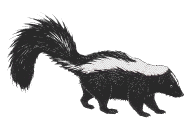What Do Animals Do in the Winter?
When winter comes animals work in many ways to prepare for the cold weather just as we do. We turn on the heat, get out our warm coats and in areas that are quite cold we buy extra food in case a storm comes
that keeps us from going to the store. Some animals grow warmer coats,
for the winter. Others waterproof their homes in order to stay dry and and warm. Some store
up food for the long winter and others migrate to warmer places until the cold weather is gone.
Some even curl up and sleep the winter away.
Let's take a look at some animals to see what they do to survive the cold of winter.
 Nappers and Hibernators
Nappers and Hibernators
Some animals hibernate,
or sleep, the whole winter away. Some animals do not sleep the whole
winter, however. These animals sleep most of the time, but from time to time when the weather is warmer,
they wake and hunt for food. Then they return to their naps.
Chipmunks are nappers. They burrow tunnels deep in the ground for winter homes. Here they store
the nuts and seeds that they have gathered for the winter. On top of their supply of food they build
a bed of grass and leaves. Here they curl up and sleep most of the winter. On a bright and sunny winter day the
chipmunk might wake and take a look at the world outside.
Squirrels also nap the winter away. Most squirrels build nests of warm leaves high up in trees
to sleep away the winter. On a warm winter day the squirrel wakes to look for the
little stores of nuts he buried away for his winter snacks.
Bats, skunks, bears, and snakes all hibernate for the winter. When animals hibernate their heart
rate slows down and and so does their rate of breathing. This helps the animal to live off the food
supplies stored in their bodies for their long winter sleep.
Bats hibernate in caves with thousands of other bats, all hanging upside down from nooks and ledges
deep within the cave. The bat's body temperature gets almost as low as the air in the cave so it is
important that they choose a cave where the temperature does not get to the freezing level.
Snakes crawl into caves, hollow logs, or other animal's burrows to hibernate. Sometimes there will be
as many as a hundred snakes in one cave.
 Female skunks burrow together for their long winter hibernation. Male skunks hibernate alone.
They often burrow under houses or barns to stay dry and warm for the winter.
Female skunks burrow together for their long winter hibernation. Male skunks hibernate alone.
They often burrow under houses or barns to stay dry and warm for the winter.
Bears eat all spring, summer, and fall to get ready for winter.
They usually try to hibernate in caves but will choose any place where there is some protection from the weather. While the female bear sleeps her cubs are born. They burrow into their
mother's fur and stay there until spring.
Turtles and frogs also hibernate in the winter. Turtles that live in the water and frogs usually burrow into the muddy bottom of the pond to hibernate.
Land turtles usually hibernate in other animal's burrows. Their shell helps to protect them from the cold.
Fish sink to the bottom of frozen lakes and ponds in the winter. They are quiet but awake. One type of fish that does hibernate is the carp. He uses his tail to cover himself with mud from the bottom of the pond. There he sleeps the winter away.
Most birds migrate to warmer climates during the cold winter season.
Some fly in large formations and fly for great distances to get to their winter vacation homes. The North American poorwill hibernates in the high Sierra Nevada Mountains. Finding a place nestled in the rocks poorwills are safe from the winter storms.
Other Places to Go to Learn About Animals
Animal Scramble
Unscramble the words below to find the names of some winter sleepers.
1. K N A S E
2. E R B A
3. R S E Q R I U L
4. K U S K N
5. G O F R
6. L U T E R T
7. N C K U P H I M
To check your answers click here.

 Female skunks burrow together for their long winter hibernation. Male skunks hibernate alone.
They often burrow under houses or barns to stay dry and warm for the winter.
Female skunks burrow together for their long winter hibernation. Male skunks hibernate alone.
They often burrow under houses or barns to stay dry and warm for the winter.
